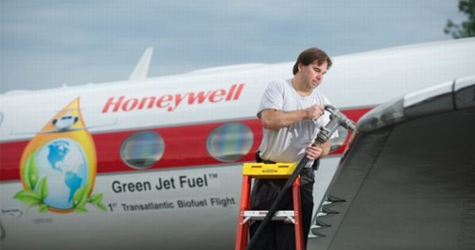Flight test will also feature in-flight collection of emissions data and use of higher blends of Honeywell Green Jet Fuel.
DES PLAINES, Ill., April 18, 2012 — UOP LLC, a Honeywell (NYSE: HON) company, announced today that Honeywell Green Jet Fuel™ will be used for the world’s first comprehensive test program using a new biofeedstock specifically designed for biofuel production.
The test flights, to be done in Canada with the National Research Council of Canada (NRC) and Agrisoma Biosciences Inc., will also feature in-flight collection of emissions by a trailing aircraft, allowing for later evaluation of the Green Jet Fuel’s emissions performance.
The program will also test blends of Honeywell Green Jet Fuel at higher ratios than previous demonstration flights, which have been conducted using a 50/50 ratio of biofuel and jet fuel produced from petroleum.
“This is a unique program of test flights, given that we are using a new feedstock to produce the Honeywell Green Jet Fuel, and it will be used in higher ratio than before,” said Jim Rekoske, vice president and general manager of the Honeywell UOP’s Renewable Energy and Chemicals business unit. “Additionally, the collection of in-flight emission will allow for further verification of the superior environmental performance of Honeywell Green Jet Fuel.”
The series of flights, expected to take place this month, will use Honeywell Green Jet Fuel produced from ResonanceTM Energy Feedstock, a new non-food, industrial oilseed crop produced by Ottawa-based Agrisoma. The feedstock is derived from Brassica carinata and is optimized for use as a biofuel feedstock. The crop is also uniquely suited for production in semi-arid areas that are unsuitable for food oilseed production, meaning it will not compete with food crops for land resources.
The Resonance crop, used to produce Honeywell Green Jet Fuel for the flights, was grown in Kincaid, Saskatchewan, in the summer of 2011.
The flights will be conducted on a modified Falcon 20 twin-engine jet. Honeywell Green Jet Fuel is to be blended beyond the 50 percent level used in past flights, which is also the level approved by ASTM, the worldwide standards body that approved commercial use of Honeywell Green Jet Fuel last year.
The flights will also feature a trailing aircraft, which will collect emissions from the Falcon aircraft while in flight for later evaluation. Previous evaluations of Honeywell Green Jet have found a 60-85 percent reduction in greenhouse gas emissions relative to petroleum-based fuels.
Honeywell UOP’s Renewable Jet Fuel Process technology was originally developed in 2007 under a contract from the U.S. Defense Advanced Research Projects Agency (DARPA) to produce renewable military jet fuel for the U.S. military. The process technology is fully compatible with existing hydroprocessing technology commonly used in today’s refineries to produce transportation fuels. It produces an aviation biofuel that can be blended seamlessly with petroleum-based fuel. When used as part of as much as a 50 percent blend with petroleum-derived jet fuel, Green Jet Fuel is a drop-in replacement that requires no changes to the aircraft technology and meets all critical specifications for flight.
Honeywell’s UOP, a recognized global leader in process technology to convert petroleum feedstocks to fuels and chemicals, is developing a range of processes to produce green fuels from natural feedstocks. In addition to its Renewable Jet Fuel Process technology, the company has commercialized the UOP/Eni Ecofining™ process to produce Honeywell Green Diesel Fuel™ from biological feedstocks. It has also a joint venture with Ensyn Corp. in Envergent Technologies LLC, which offers pyrolysis technology for the production of renewable heat, power and transportation fuels.
Media Contact:
Krystal Hughes
(847) 391-3561
Share your industry press now!
Are you a PR agency or sustainability-focused organization? Join the World of Renewables network FREE today and gain exclusive access to our platform to promote your business, share the latest industry news, and connect with a global audience of 700,000+ renewable energy professionals.
Register Now to start posting your updates and showcase your expertise to a highly engaged, environmentally-conscious community.
Find out more about our Content Partnership Programs.*2024 AWARD WINNER* Websites & Mobile Sites, Webby Winner, Peoples Voice 2024






















